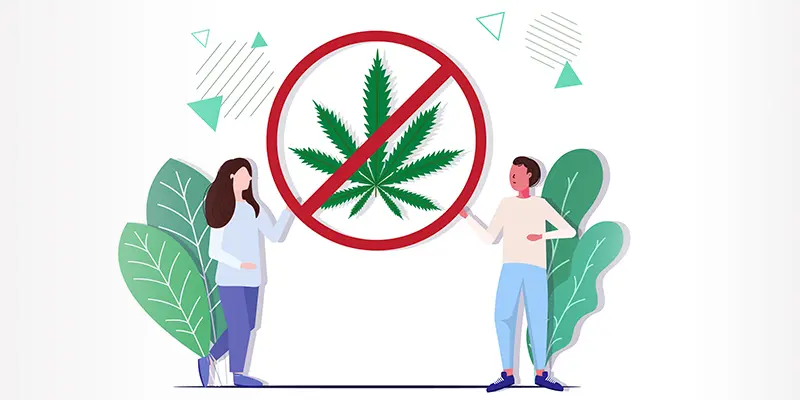Welcome to Clear the Smoke today we will delve into the eight levels of marijuana withdrawal symptoms, drawing a comparison to the levels of a video game. These levels are instrumental in understanding the process of quitting THC and achieving success in your journey towards sobriety. Our goal is to provide you with valuable hacks and a cheat sheet to navigate levels one through seven, ultimately reaching level eight.
Level 1: The Fear of Change

Level one typically occurs just before quitting THC, characterized by fear. Many people fear life without weed, worrying if they’ll ever have fun again or how they’ll handle stress. However, an often-overlooked fear is what happens if they continue smoking. To overcome level one, write down your goals and reasons for quitting. Create a list of recovery goals that give you something positive to focus on. Remember, quitting is about gaining a better life, not giving up.
Level 2: The Initial Excitement

Level two arrives in the first 24 to 48 hours, marked by excitement and confidence in your decision. Acknowledge that this excitement is temporary, just like any emotion. Approach quitting THC as a long-term investment, with highs and lows. Don’t just invest in yourself when you’re feeling good; do it when you’re facing challenges too.
Level 3: Physical Withdrawal Symptoms

Around days three to five, level three hits with physical weed withdrawal symptoms such as sweating, insomnia, and agitation. View these symptoms as addiction leaving your body, a sign of your progress. Maintain your journey by eating healthy, staying hydrated, getting rest, and engaging in gentle exercise to release endorphins.
Level 4: The Mental Struggle

Between days seven and ninety, level four introduces mental cannabis withdrawal symptoms, including cravings and frustration. Build a strong support system through talk therapy, friends, family, or support groups. Avoid frustrating tasks and situations that may increase doubt and the risk of relapse.
Level 5: Anhedonia – The Lack of Joy

Around days seven to ninety, level five brings anhedonia, where you struggle to find joy in activities. To combat this, establish a routine with activities that offer consistent, steady rewards. Over time, these activities will release dopamine and bring back a sense of joy.
Level 6: Beware the Pink Cloud

Level six is known as the “pink cloud syndrome.” You might feel invincible, but it’s crucial to remember that these emotions are temporary. Don’t celebrate by using a substance; instead, stay committed to your sobriety.
Level 7: Steady Progress

Between days 30 and 90 and onward, level seven is about maintaining your progress. Develop and use coping mechanisms such as talk therapy, exercise, or hobbies that offer long-term rewards. Focus on consistency to keep you steady in your recovery.
Level 8: Ongoing Recovery

Level eight involves post-acute cannabis withdrawal symptoms and requires ongoing patience, discipline, determination, and commitment to your journey. Understand that recovery is a lifelong process. The most significant rewards often come after the initial stages, so be patient and committed to your sobriety.
Remember, you’re not alone in this journey. Seek support from resources like therapy, friends, and family. With dedication and the right mindset, you can successfully conquer each level of weed withdrawal and achieve lasting sobriety. Stay strong and stay committed to your recovery journey.
Conclusion
Understanding and navigating the eight levels of marijuana withdrawal is essential for anyone on the path to sobriety. Each level presents its unique challenges, from initial fears to physical and mental symptoms, and even moments of elation. However, with the right mindset and strategies, you can successfully overcome these hurdles.
Remember, quitting marijuana is not just about what you’re giving up but also about what you’re gaining in life—better health, improved relationships, financial stability, and mental clarity. It’s a journey worth embarking on.
Frequently Asked Questions(FAQs)
What Are Common Symptoms of Marijuana Withdrawal?
Answer: Common symptoms of marijuana withdrawal include anxiety, irritability, insomnia, loss of appetite, mood swings, and physical discomfort. These symptoms can vary in intensity depending on individual factors.
How Long Does Marijuana Withdrawal Last?
Answer: The duration of marijuana withdrawal can vary from person to person. In general, acute withdrawal symptoms may peak within the first week and gradually improve over two to three weeks. However, some individuals may experience lingering symptoms for several months, known as post-acute withdrawal syndrome (PAWS).
Are There Any Medications to Help with Weed Withdrawal?
Answer: Currently, there are no FDA-approved medications specifically for treating marijuana withdrawal. However, healthcare professionals may recommend medications to address specific symptoms, such as anxiety or sleep disturbances, on a case-by-case basis.
What Can I Do to Manage Cannabis Withdrawal Symptoms?
Answer: Managing withdrawal symptoms involves adopting healthy coping strategies. These can include regular exercise, maintaining a balanced diet, practicing relaxation techniques (like deep breathing or meditation), seeking support from friends and family, and engaging in therapy or counseling.
Is Relapse Common During Marijuana Withdrawal?
Answer: Relapse can occur during marijuana withdrawal, especially during challenging phases like the “pink cloud syndrome.” It’s essential to be aware of triggers and have a relapse prevention plan in place. Seeking support from a therapist or support group can be instrumental in maintaining sobriety.

